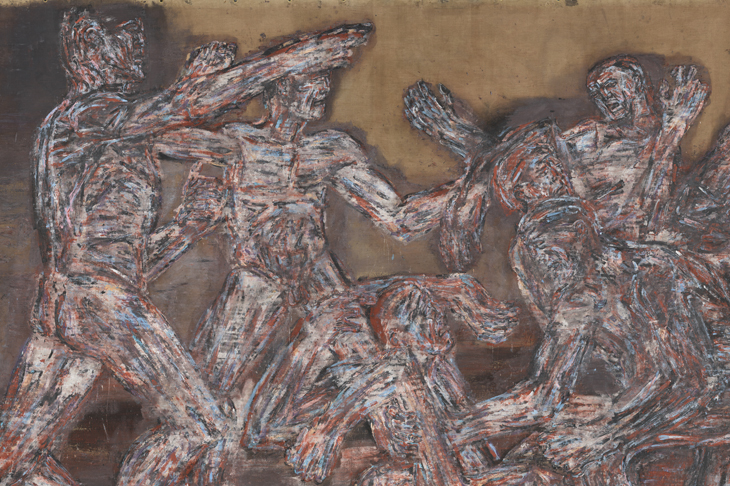There is no soft introduction to the Met Breuer’s exhibition of the work of Leon Golub (1922–2004). As the elevator doors open on to the gallery’s second floor, viewers are immediately confronted with a huge unstretched canvas depicting a brutal fight scene. The male figures of Gigantomachy II (1966) look like hunks of meat, all red and blue and sinew, limbs tangled, fists flying. In terms of ferocity and scale the painting’s right up there with Picasso’s Guernica, while its composition and muscular style recalls a classical frieze – its title refers to an epic battle from Greek mythology between gods and giants. The figures, apparently stripped of their skin and therefore ambiguous as to ethnicity or individual identity, seem to represent the violent essence of man. It is immediately clear from where the subtitle for this exhibition, ‘Raw Nerve’, is drawn, with this painting acting as a manifesto of sorts for what’s to come.
Winged Sphinx I (1972), Leon Golub. The Metropolitan Museum of Art, New York © The Nancy Spero and Leon Golub Foundation for the Arts/Licensed by VAGA, New York, NY
This taut survey of Golub’s work continues with a room devoted to the Chicago-born artist’s interest in the history of art and the classical world, which stemmed from his undergraduate studies in art history at the University of Chicago in the early 1940s, and grew during his years living in Europe with Nancy Spero, his wife, between 1959 and 1964. Throughout Golub’s long career, scenes from ancient history, depicting monstrous battles and bloodshed, would be employed as symbols for contemporary political conflicts. The screenprint Winged Sphinx (1972) is one of his more refined and faithfully classicist renderings, while paintings such as Dead Bird II (1955) and Colossal Torso III (1960) demonstrate how Golub transformed classical imagery through his own distinctive style – the former’s morbid ornithological subject is styled as a Hellenistic mask; the latter is rendered in Expressionist strokes of stone colours flecked with flashes of green and blue, conjuring an image of a weathered sculptural artefact.
Golub’s other fascination is with a particular breed of violent, power-bent masculinity, as found across time and in different cultures. His brutal subjects – mobs, fight scenes, dictators – seem themselves to have been constructed with a violence and anger directed towards the image, strokes of paint applied in an apparently frenzied manner before being roughly scraped away with meat cleavers. There is a lack of female presence in these hyper-masculine scenes, and when a female figure does appear, it adds a disquieting dynamic. One lithograph, entitled The Brank (1984), depicts a ‘brank’s bridle’ – a device for silencing ‘troublesome’ women with recorded use as recently as the 19th century – here reimagined as a sadomasochistic object. In the unsettling Horsing Around IV (1983), an off-duty white soldier leers, drink in hand, over a seated black woman.
Two Black Women and a White Man (1986), Leon Golub. Courtesy Ronald Feldman Gallery, New York; © The Nancy Spero and Leon Golub Foundation for the Arts/Licensed by VAGA, New York, NY
Golub was outspokenly critical of violent abuses of power and atrocities taking place throughout his lifetime. Upon their return from Europe, Golub and Spero became members of the activist group ‘Artists and Writers Protest Against the War in Vietnam’. As the war intensified, Golub created his unflinching series of paintings, Vietnam and Napalm. This was a turning point for his work, whose hitherto more general explorations of power and violence were now directly responding to specific conflicts. In the 1980s he turned his attention to the systematic torture of dissidents by mercenaries in South America and the South Africa under apartheid. A smart pairing at the Met Breuer brings together two large-scale paintings referring to the latter. In The Conversation (1990), two black men casually lean in front of a Black Power mural, which depicts a third figure, fist raised in empowered salute, appearing to survey the scene before him. Adjacent to this, the trio of figures in Two Black Women and a White Man (1986) is divided into two separate groups; no-one is making eye contact with anyone else. This quiet image is in some ways a more potent exploration of the systemic effects of power than the spectacles of violence elsewhere. While the male figure gazes ambivalently off to the right, one of the women stares directly out from the canvas, a challenge to the viewer’s passive act of witness.
All Bets are Off (1994), Leon Golub. The Metropolitan Museum of Art, New York. © The Nancy Spero and Leon Golub Foundation for the Arts/Licensed by VAGA, New York, NY
This latter half of the exhibition sees Golub’s palette become more vibrant, although his subjects remain dark in nature, as demonstrated by two of the late paintings presented in this exhibition: All Bets Are Off (1995) and Bite Your Tongue (2001). Neither of these paintings takes place in a specified geographical location. They are ambiguously set in a nondescript dystopian wasteland, populated with an array of figures and forms: sneering satyrs, skulls and snarling dogs. No longer depicting a single unified scene but an amalgamation of motifs, whose sources range from the classical world to the contemporary, these fragmented compositions suggest the inevitable omnipresence of darkness in existence.
Gigantomachy II (1966), Leon Golub. The Metropolitan Museum of Art, New York. © The Nancy Spero and Leon Golub Foundation for the Arts/Licensed by VAGA, New York, NY
The driving force behind the staging of the exhibition is the Met’s recent acquisition of Gigantomachy II and Vietnamese Head (1977) for the museum’s collection. However, as conflicts continue to rage across the globe and society’s patriarchal structures find themselves under increased scrutiny, Golub’s bleak manifestations of brutality, hyper-masculinity and the misuses of power are as difficult to confront now as ever.
‘Leon Golub: Raw Nerve’ is at the Met Breuer, New York, until 27 May.
